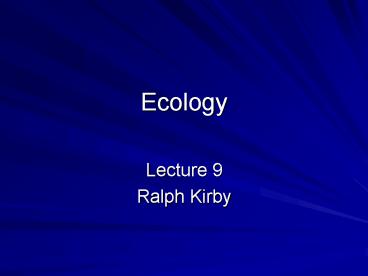Ecology - PowerPoint PPT Presentation
1 / 18
Title:
Ecology
Description:
Lion and wild dogs over a antelope kill. Mathematical approach. N: population size. t: time ... Grass species southern African savanna. Species change. 1971 to ... – PowerPoint PPT presentation
Number of Views:28
Avg rating:3.0/5.0
Title: Ecology
1
Ecology
- Lecture 9
- Ralph Kirby
2
The struggle for Existence
- Remember Population Interactions
- Neutral 0 0
- Mutualism
- Competition - -
- Note interspecies competition
- Seek a common resource in short supply
- Food Living space etc
- See squirrels, mice, deer, various birds
competing for acorns - Model One. Two forms
- Exploitation
- Interference
- Model Two. Six forms
- Consumption
- preemption\
- Overgrowth
- Chemical interaction
- Territorial
- encounter
3
- Consumption
- Utilization of a shared resource by 2 species
- Preemption
- Occupation of a site by 1st organism stops
occupation by 2nd organism - Usually sessile organisms
- Overgrowth
- Where organism covers another preventing access
to a resource - Light in rain forest
- Chemical interaction
- Release of toxin to kill competing organisms
- Antibiotics in soil by Streptomyces
- Territorial
- Behavioral exclusion of 1st organism by 2nd
organism defending territory - Encounter
- Non-territorial encounters cause a negative
effect on one or both species - Lion and wild dogs over a antelope kill
4
Mathematical approach
- N population size
- t time
- K carrying capacity
- r rate of increase
- aN1 and ßN2 effect of interspecific competition,
namely, where a and ß per capita effects of
competition - Species 1
- dN1/dt r1N1((K1-N1-aN2)/K1)
- Species 2
- dN2/dt r2N2((K2-N2-ßN1)/K2)
- No interspecific competition, then a and ß are 0
and normal growth to carrying capacity - Interspecific competition is density dependent
5
- (a) Species 1 alone or no competition
- (b) Species 2 alone or no competition
- (c) Species 1 inhibits growth of species 2 and
latter goes extinct - (d) Species 2 inhibits growth of species 1 and
latter goes extinct - (e) Unstable situation, both inhibit in a density
dependent manner. Depending on initial density,
either can make other extinct - (f) Each species inhibits its own population
growth more than competitor. Neither can
eliminate competitor - Diagonal lines are zero growth isoclines
6
Laboratory experiments to verify Lotka-Volterra
Equations
- Two Paramecium
- One with higher rate of growth
- Extinction of slower grower
- With different food supplies
- Coexistence
- Two Diatoms
- Require silica in water for growth
- Adequate silica
- Coexistence
- Inadequate silica
- One goes extinct
7
Competitive exclusion principle
- Two species possessing exactly the same
ecological requirements cannot coexist - One species must go extinct
- Not normal situation
- Immigration
- Use of other resources
- No selection
- No changes in the environment
- Thus most of the time species can coexist
8
- Thus if environment varies
- Then competition varies
- See secondary succession success in graph
- Also moisture
- Grass species southern African savanna
- Species change
- 1971 to 1981
- Low rainfall in 1971-1973
- This is the norm
9
- Systems are not simple one resource situations
- Usually competition for more than one resource
- Territorial defense against wide range of other
species - Plants
- Monoculture
- Root competition
- Skeleton weed reduce by 35
- Shoot competition
- Skeleton weed reduced by 53
- Root and shoot competition
- Skeleton weed reduced by 69
- Thus clover superior to skeleton weed for all
resources
10
- Effect of interspecific competition across an
environmental gradient - Note changes in response when in mixture
11
- Similar effect for summer annuals and moisture
gradient - Also happens in nature with water, anoxia and
salt stress in a salt marsh - Chipmunks
- Alpine
- Cold tolerant
- Lodgepole
- Most aggressive
- Needs shade
- Yellow Pine
- aggressive
- Least
- Heat tolerant
12
(No Transcript)
13
- For competing species to all survive
- Partitioning of resources
- Cat species in Israel
- Cats with larger canines can kill bigger prey
- Note regular spacing of sizes
- Therefore distinct prey groups
14
Evolution is thus affected by competitionSelectio
n causes changes in resource utilization
15
See finches on Galapogos islandsBeaks of same
species are different when they compete
16
- Fundamental Niche
- Where species can exist with no competion
- Realized Niche
- Niche utilized under competition
- See cattail in water depth experiment
- See two models for species competition
- Compression
- Splitting to suboptimum periphery
17
- See effect of environmental gradients
- Note effect of competitive release
18
(No Transcript)































